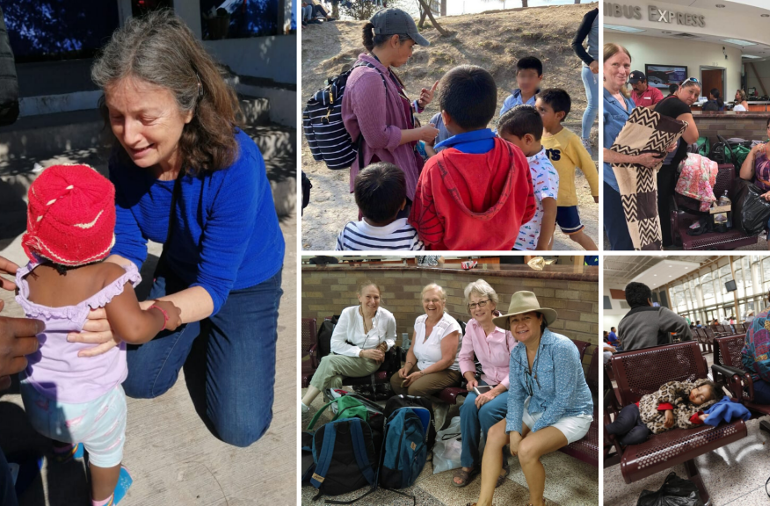With the coronavirus pandemic stalking the asylum seekers waiting nervously in camps and shelters all along the border and in the overcrowded jail cells of the US justice system, inspiration from the border is very hard to come by these days. Thanks to the Angry Tías and Abuelas for shining a light in the darkness, and to London journalist Sarah Towle for sharing their story, and other tales of humanity and heroism from her 2,000-mile journey along the US-Mexico Border.
We landed in Brownsville on Jan. 3, 2020, with a car reservation, three nights pre-booked into a hotel, and a single contact. This was not the plan.
The plan was to have folks waiting for us all along the Tex/Mex border. From Labor Day to Thanksgiving, I emailed every organization I could find from Brownsville to El Paso. By Christmas, I’d heard back from none.
Jim was growing skeptical. “We’ll just show up. It’ll work out. You’ll see,” I told him.
“And if it doesn’t, we’ll have more time to spend in Big Bend.”
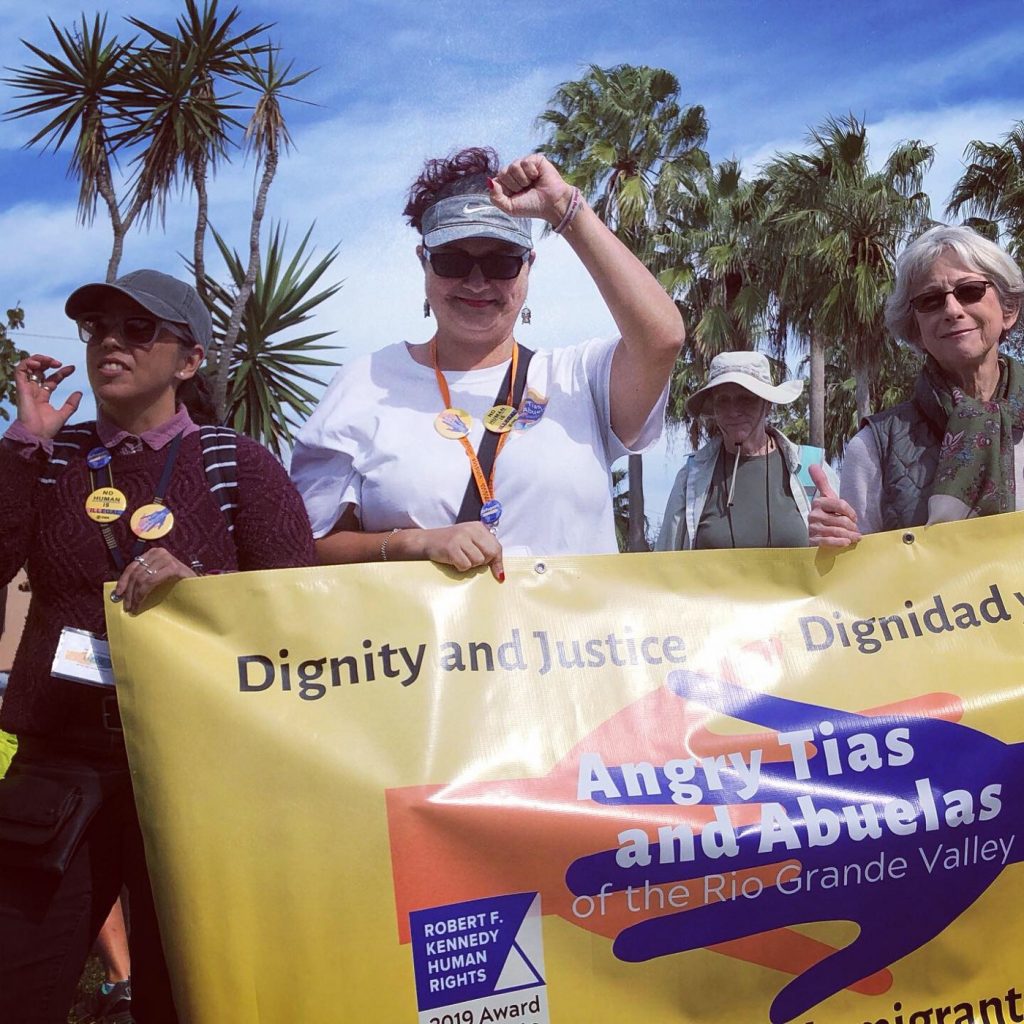
Elizabeth “Lizee” Cavazos, Cindy Candia, Susan Law, and Joyce Hamilton of Angry Tias & Abuelas at the #RestoreAsylumNow Vigil, January 12, 2020 (photo: Sarah Towle, 2020)
Finally, the day before our departure from London, on December 27, 2019, I heard back from Susan Law of the Angry Tías & Abuelas of the Rio Grande Valley. I’d contacted them at the suggestion of RAICES, the Refugee and Immigrant Center for Education and Legal Services, which — along with the Interfaith Welcome Coalition — had been the first to respond when US Immigration and Border Enforcement (ICE) employees started dumping asylum seekers, mostly dazed and confused women and children, at the San Antonio bus station in April 2018.
“Sarah, I’m so sorry about the delay in responding to you! We are looking forward to your visit and are grateful for yours and your husband’s offer to help. Our Tia Cindy, copied here, has offered to meet with you on January 4 and can accompany you across the border to give you an orientation.
We don’t have a really organized set of tasks for volunteers to do. The refugees living at the camp are grateful for people who come to visit with them, showing them they are not forgotten.” — Tía Susan

Jennifer Harbury, Cindy Candia, Joyce Hamilton, Nayelly Barrios
This is What Democracy Looks Like
In spring 2018, Jennifer Harbury had been keeping her eye on the Rio Grande Valley bridges. A long-time civil rights attorney and dedicated refugee advocate who’d lived in the RGV for four decades, she knew that any shift in border activity to the west portended something coming east. And by all reports — increased CBP intimidation and ICE abuses, the government’s suspension of Legal Orientation Program as well as parole for pregnant women — whatever was coming wasn’t good.
Sure enough, it would flow to the Reynosa-McAllen bridge in the final days of May.
Jennifer messaged her colleague Kimi Jackson, Director of The South Texas Pro Bono Asylum Representation Project (ProBAR). Urgent help needed! she stated.
Forty people had been stranded on the bridge for five days. They had no food, no water, they were completely exposed to the elements. Some were barefoot, their shoes having fallen apart on the journey across Mexico. All were desperate.
Kimi lost no time. She contacted her trusted comrade in LGBTQ-rights activism, Cindy Candia, as well as her neighbor, a retired adult literacy educator and Presbyterian Elder, Joyce Hamilton. The three sprung into action, calling on others to help them form a caravan to deliver to the bridge as many sandwiches as they could make as well as snacks, diapers, pedialyte, whatever they could pull together on a dime.
Cindy, an ex-correctional officer and the daughter of migrant farmworkers, emptied her cupboards into a large picnic cooler, “Because my husband and I were between paychecks at the time.” On the hour-long drive from Harlingen, TX, she and the others couldn’t stop asking, Why isn’t Customs and Border Patrol letting them in?
What the three women found at the bridge on June 3, 2018, defied explanation and challenged the imagination: A scrum of men, women, babies, and children pressed up against the US border control office at the bridge’s north end. They’d been sleeping on bits of found cardboard, washing in a nearby water fountain, and taking turns using the bathroom at the UETA duty-free shop in Mexico.
“They were literally stuck there,” Joyce recounted.
The triple-digit Texas sun scorched the asphalt, burning their feet. There was nowhere to sit. Babies needed new diapers, women needed clean underwear. Everyone needed a change of clothes and a bath. Some needed medical attention. Freelance writer and then-McAllen resident, Daniel Blue Tyx, called it, “a refugee camp on the bridge.”
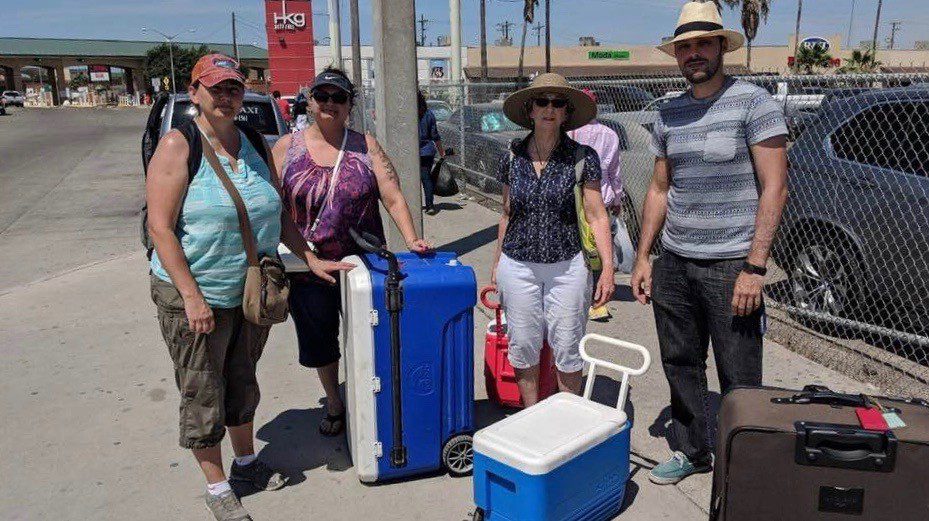
The first cooler caravan to serve the needs of asylum seekers stranded on the Reynosa-McAllen bridge, June 3, 2018. Pictured in the middle: Cindy Candia and Joyce Hamilton. (Photo courtesy of Joyce Hamilton)
Seeing to the Common Good
Back at home that night, Kimi tapped out a call to action on her Facebook page, describing what she’d seen and asking for volunteers and/or money to help support the needs of the trapped asylum seekers. She included a shopping list.
Nayelly Barrios was among the first RGV residents to receive Kimi’s message. A Mexican immigrant, poet and University of Texas-RGV professor, she lived close to the bridge, in Edinburg, and was then on summer break. She dashed right over with supplies from Kimi’s list, but not without first sharing the call for help with her Facebook friends. She received $200 in donations overnight.
When Joyce and Cindy met Nayelly face-to-face for the first time four days later, the refugee camp on the bridge had grown from 40 to 70. CBP was still processing asylum claims, but slowly — around 10 per day — meaning more people were joining the queue than leaving it. By day, they were forced up against the outside, metal barrier of the walkway to allow the thousands of pedestrian border-crossers to pass on the left. Their long, single-file line extended from the mostly empty, air-conditioned CBP office big enough for 100 to the bronze plaque at the middle of the bridge that marked the official US/Mexico boundary.
On June 11, Nayelly sent a frantic group message to Kimi, Cindy, Jennifer, and Joyce: she’d arrived at the bridge to see CBP officials pushing the entire line of asylum seekers back to the international mid-point. Also that day, Attorney General Jeff Sessions announced that the Trump administration had rolled back asylum protections for victims of domestic and gang violence. The decision would affect nearly every individual and family running from the Northern Triangle countries of Honduras, El Salvador, and Guatemala, as well as Nicaragua, where decades-long corruption and US-backed military training, along with a surfeit of weapons, had bred cultures of impunity.
Throughout Central America, where gangs rule, even the worst crimes go unpunished. Few are safe. Small business owners face extortion; murder if they don’t pay up. Women and girls face the threat of rape and/or kidnapping for ransom and/or sex slavery. Families face the threat of gangs pressing their boys into work as drug runners for the cartels. Everyone faces violence everyday as the dead and mutilated are left where all are reminded who’s really in charge.
So, yes, those who’ve chosen to pull up stakes and make the long, dangerous trek to the US border on foot, because they cannot afford to fly, are literally running for their lives.
Yet from that moment forward, those fleeing persecution to seek safe haven in the US, as is their right under international law, would face the same hostility as those trying to sneak in. Now, upon reaching US ports of entry, asylum seekers would have to add their names to an official CBP list, then wait in Mexico to be called.
Only an audience with CBP officials would kick-start the asylum process, and you never knew when you’d be called. Meantime, Trump’s own State Department had placed Mexico under a level-4 travel advisory, along with Syria, Iran, and Iraq, especially at the border.
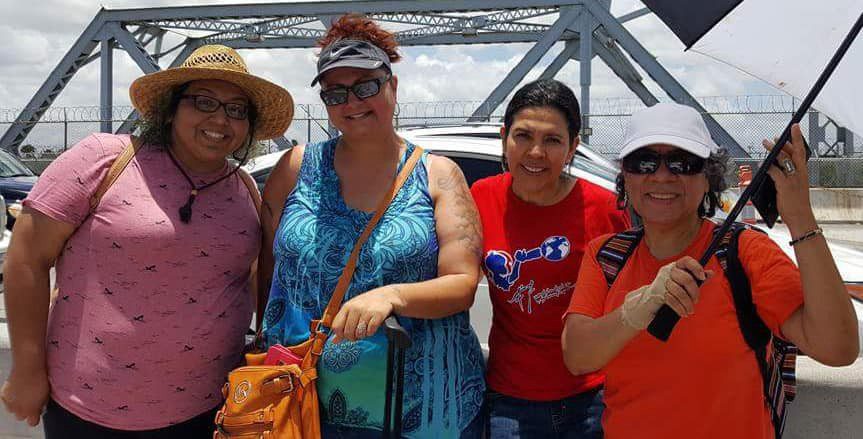
Nayelly Barrios, Cindy Candia, Gladys Aguilar, and Mary Cano on the Brownsville/Matamoros (B&M) bridge, summer 2018 (photo credit: NETA-RGV)
‘Metering’ Asylum
McAllen was no longer just ground zero for Trump & Co’s family separation debacle. It was now a place where the right to asylum was eroding as well. The border was closing: a wall had indeed gone up, although one more metaphorical than physical. The practice of “metering” had begun. Seeking asylum would now function much like the Department of Motor Vehicles: take a number and wait your turn. In some cases, that might mean days; in others, it could go on for weeks, or months. The most desperate chose the river, risking death or criminal arrest, which meant prolonged detention and the removal of their children — a new face of family separation.
What Cindy, Nayelly, and Joyce saw in June 2018 was injustice, plain and simple. They were angry. Jennifer saw torture and crimes against humanity. She was angry, too. So angry, she asked Kimi to invite everyone to her house to brainstorm a coordinated response to the humanitarian crisis unfolding before their eyes: not only at the bridges, but at courthouses, detention centers, bus stations, and processing centers all across the Rio Grande Valley.
Kimi’s hands were full. She was already working around the clock, as was another area lawyer, Jodi Goodwin, to defend immigrants’ right and provide pro-bono counsel to detained women who’d been robbed of their kids. She passed the task of coordinating everyone’s schedules to Joyce, who set the date — June 13 — then called her sister, Linda, in San Antonio.
Linda had been volunteering with Sister Denise LaRock and Lena Baxter, co-directors of San Antonio’s Interfaith Welcome Coalition (IWC), to support the asylum seekers ICE had been dumping at bus stations up north. As luck — or serendipity — would have it, Sister Denise and Lena were, at that very moment, on their way to McAllen. They’d heard that Trump & Co had turned up the hate again, and they wanted to see for themselves what was going on. Joyce extended them an invitation to the meeting as well.
Meanwhile, Cindy brought along a couple of activists from NETA-RGV, an independent media platform founded upon Trump’s election to support and amplify the voices of Rio Grande Valley residents. She thought it wise to have members of the press involved, but their presence turned even more critical: when Jennifer suggested they mount a fundraiser, the NETA crew agreed to take that on. They brought in $72,000 the first month. Donations only went up from there.
NETA-RGV had the organizational infrastructure. The angry women who’d gathered that evening had neither formal organization nor name. But that wouldn’t last long.
At one point during the meeting, Jennifer remarked, “You all sound like a bunch of angry tías.” In fact, they were all aunties. The comment lightened the mood a bit. It made them all laugh. But it got them thinking, too.
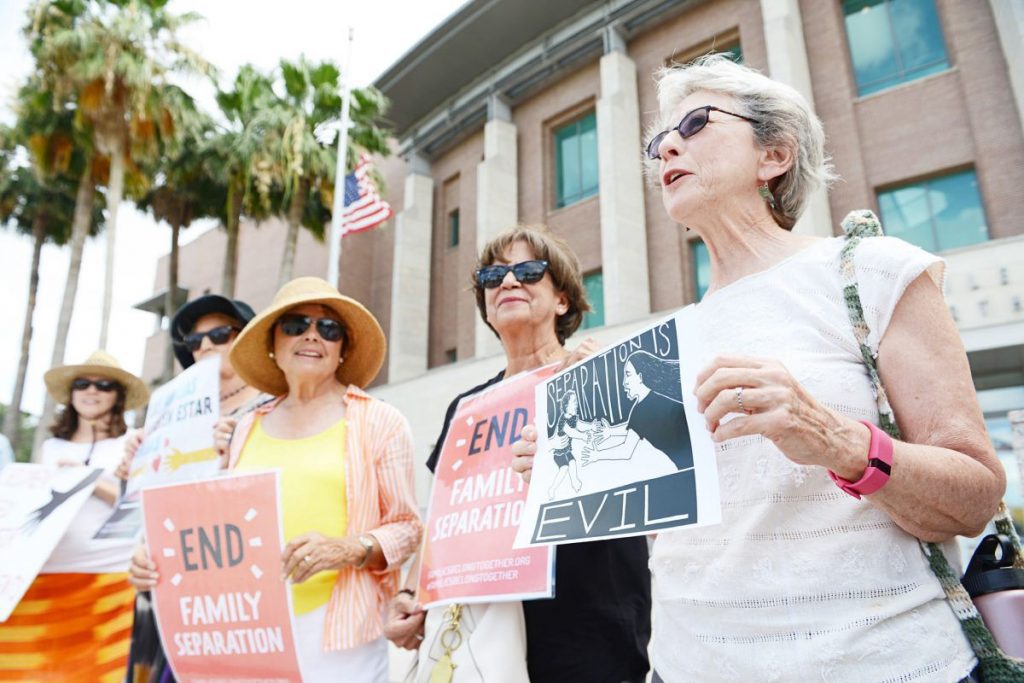
At Federal Courthouse in Brownsville, TX, local citizens protest family separations on June 14, 2018. Madeleine Sandefur (in yellow) and Joyce Hamilton (far right), pictured. (photo credit: Brownsville Herald)
The Angry Tías & Abuelas of the Rio Grande Valley
The very next day, June 14, 2018, Joyce was at the Brownsville Courthouse with her birder friend, Swiss-born, US-naturalized Madeleine Sandefur, the wife of a US Airman from San Antonio she’d met in Paris in the 1970s. In addition to both being Texas Master Naturalists, and on the front lines of a public protest to save South Padre Island habitats from the development of liquefied natural gas export terminals, the two had helped to organize Brownsville’s Women’s March on Jan. 21, 2017.
This day, they brandished placards decrying the separation of migrant families at the border.
They had been very busy, as you can imagine. Madeleine was instrumental in getting the protest off the ground. And Joyce, alongside Cindy, had not stopped her continued round trips from Harlingen to the Reynosa-McAllen bridge, with massive shopping sprees in between. So when a reporter asked them, on mic, what they thought of US Attorney General Jeff Sessions using the Bible to defend family separations, they responded with mouths agape and blank stares. “We were like deer in headlights,” Joyce said.
Pointing the mic to himself, the reporter paraphrased what Sessions had said: “I would cite you to the Apostle Paul and his clear and wise command in Romans 13, to obey the laws of the government because God has ordained them for the purpose of order.”
Well! A woman of faith, Joyce had a few choice spontaneous words to say about that! She grabbed the mic and, though typically reserved, began railing against the gall of the man invoking the same biblical passage that had been used to justify slavery to defend ripping children out of the arms of loving parents. How dare he!
Jennifer, who stood right next to Joyce on the courthouse steps, commented that she sounded more like a rampaging abuela than an angry tía. And the name of the group was born:
The Angry Tías & Abuelas of the Rio Grande Valley.
Before the march was over that day, Madeleine, also a grandmother, had joined their ranks as well — “because this was not what I signed on to when I became a US citizen.” A former office manager, she took on the responsibility of handling the group’s finances and scheduling.

Clockwise from left: Tía Jennifer with toddler, Reynosa, Mex; Tía Lizee with migrant children, Matamoros, Mex; Tías Susan, Cindy, Joyce, McAllen Bus Station; Tía Susan with mother and child refugee, McAllen Bus Station; Tías Elisa and Joyce with volunteers, McAllen Bus Station (photos courtesy of @AngryTías)
The Cries that Woke a Nation
Shortly thereafter, another friend of Madeleine and Joyce’s, naturalist, bird-enthusiast, and mental-health professional Elizabeth “Lizee” Cavazos, waded into the effort. She agreed, at first, to help orient released refugees at the McAllen bus station one day each week.
But on hearing the heartbreaking cries of children separated from their parents at the Ursula Processing Center — aka La Hielera (the icebox), so named for its extremely frigid temperature — she was moved to full-time activism. “I realized then, if I don’t act to stop Trump’s crimes against humanity, then I’m complicit in committing them.”
That now-famous recording had been leaked to a reporter at ProPublica by none other than Jennifer. She had obtained it from an unnamed whistle-blower inside Ursula, and passed it to a trusted member of the press. It would sweep across a shocked nation and promptly bring Trump & Co’s family separation policy to its knees.
By July, families were being allowed to go to their sponsors in the US again. And they were coming to the border in droves. Anywhere from 200 to 900 refugees landed at the McAllen bus station every day between July 2018 and July 2019. They had no money, little if any English, and no idea how to get where they were going.
Before she knew it, Lizee was working full time at the McAllen bus station alongside Jennifer’s long-time friend and colleague Susan Law, retired Human Resources Director for Texas RioGrande Legal Aid. On behalf of the Tías, the two joined forces with Sister Norma Pimentel of the Catholic Charities Humanitarian Respite Center to assist refugees who, like those helped by RAICES and IWC in San Antonio, were being dumped, stunned and resourceless, by ICE and CBP.
Susan, Lizee, and their small army of volunteers were there every day, seven days a week, for a year, to help these folks prepare for bus trips that might go on for two or three days. The Tías provided them with food; travel money; maps of the US marked with their individual itineraries; a list of key English phrases and practice in how to pronounce them; and, until bus station authorities stopped them, backpacks that had been stuffed with essentials by a fast-growing team of volunteers, mostly from Harlingen, working out of the fellowship hall at Joyce’s church, when it was available, or her house, when it was not.
“It was a HUGE operation,” she remembers. “We needed a lot of space.”

Susan Law, Lizee Cavazos, Madeleine Sandefur, Elisa Filippone
Evil Flowed East with the River
The chaos did not stop at McAllen. It soon flowed east to the Rio Grande’s last stop before spilling into the Gulf of Mexico: Brownsville. There, on Friday, July 27, 2018, just as she was climbing into bed, Elisa Filippone received a call. She had been monitoring the bus station, and had previously scratched out her number on a Post-it note, leaving it at the Greyhound ticket counter. Though from an unknown number, something told her to answer the phone. On the other end of the line was a Greyhound employee. A woman, newly released from ICE detention, had been dropped off at the bus station. It would be closing in 10 minutes at 11pm. Could Elisa help her out, so she wouldn’t have to sleep outside?
Elisa pulled on some jeans and a tee-shirt, and holstered her gun, “this being Texas,” and hurried to the station a half-block from her house. With Madeleine’s “okay,” she checked the 30-year-old mother from Honduras, Jessica, into a hotel. She was back the next day to set Jessica on her way to South Carolina where she was to be reunited with her small daughter. The two had crossed the Rio Grande with a coyote and turned themselves in to Border Patrol when ‘zero tolerance’ was roiling. They were taken to La Hielara in McAllen, wet and cold, with nothing but a mylar blanket and each other for warmth. The next morning, a CBP employee said he’d take the little girl to “get cleaned up.” He assured Jessica that they’d be back in 30 minutes. She hadn’t seen or heard from her daughter since.
Many more distraught mothers and fathers as well as aunts, uncles, siblings, and cousins, would follow in Jessica’s footsteps, from CBP processing or ICE detention to the Brownsville bus station. So, Elisa formed part of the Tías effort to coordinate with area homeless shelters, in this case the Good Neighbor Settlement House, to provide refuge for newly released refugees.
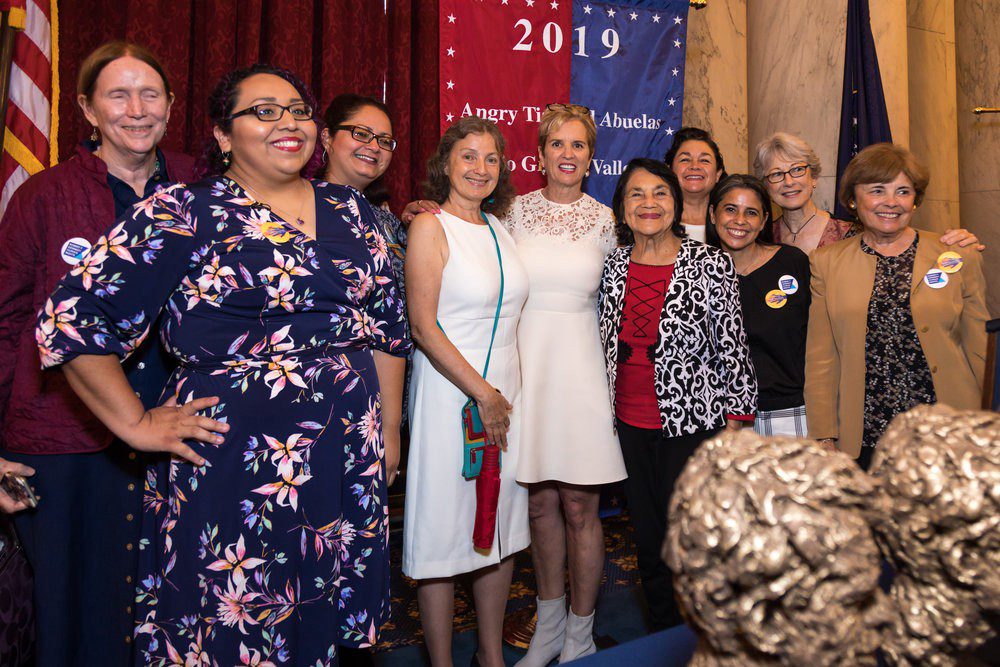
The Angry Tías y Abuelas of the Rio Grande Valley at their induction ceremony as Robert F. Kennedy Human Rights Laureates, 2019, from left to right: Tías Susan, Nayelly, Cindy, and Jennifer; Kerry Kennedy, daughter of RFK; labor leader and Civil Rights activist, Dolores Huerta; Tías Elisa, Lizee, Joyce, and Madeleine
And when asylum seekers began to form on the Matamoros side of the two Brownsville bridges, Elisa, like her counterparts in McAllen, began the daily treks to Mexico to deliver much appreciated necessities. Supplies included water, socks, and specifics, like diapers or menstrual pads, purchased online by Madeleine, or by Cindy and Nayelly, who made regular multi-cart shopping trips en route back and forth to help asylum seekers still encamped and spilling off the international bridges into Mexico. Jennifer aided the bridge brigade and managed efforts to support the migrant shelters in Reynosa, now bursting at the seams. She communicated tirelessly with national immigrant rights organizations, the ACLU, and congressional representatives in Washington, keeping all updated and aware of what was happening in the RGV. And Madeleine, who lived just miles from where women detainees were being held — the Port Isabel Detention Center (PIDC) — spent countless hours comforting distraught mothers, offering them hope that they would see their children again — no small task given the government kept scant records.
These eight heroic women — Jennifer, Joyce, Cindy, Nayelly, Madeleine, Lizee, Susan, and Elisa — all angry tías or abuelas, mobilized around the mission of bringing dignity and justice to human beings that America-Made-“Great”-Again had kicked back to places so dangerous, they were afraid to leave the bridges.
All through the long, hot summer of 2018, the Angry Tías and Abuelas saw to the needs of men, women, and children caught in the crosshairs of cruel, complicated, and constantly shape-shifting immigration policies. They believed the practice of “metering” was too mean to last; that it would be over by the summer’s end. But when Jim and I showed up to volunteer with them 19 months later, in January 2020, the first 40 souls they’d discovered on the Reynosa-McAllen bridge had swelled to 2500, now living in tents and under constant danger in cartel-controlled Matamoros, just across the river from Brownsville.
And that was just one bridge along a 2,000-mile border.
By the end of 2018, “Metering” had evolved to become Trump & Co’s Migrant “Protection” Protocol, otherwise known as Remain in Mexico because it didn’t provide any protection at all. MPP kicked asylum seekers back into Mexico even after their names had been called and their asylum claims started. It forced them to represent their asylum claims by themselves in kangaroo courts held under US-based big top tents where “justice” was just another circus. And it would render more than 60,000 innocent and traumatized people, right now living in tent cities all along the border — many without access to soap and running water — sitting ducks to the COVID-19 virus: a 2000-mile humanitarian crisis teetering on the edge of genocide.
I’m a tía, I thought. And I’m angry. Very angry. I wrote Susan right back, telling her I should fit right in.
Click here to learn more about the Angry Tías y Abuelas of the RGV. Consider donating to help bring dignity and justice to asylum seekers stranded in Mexico. The Tías are still working on their behalf. Thank you!
“Let us be reminded that before there is a final solution, there must be a first solution, a second one, even a third. The move toward a final solution is not a jump. It takes one step, then another, then another.”
— Toni Morrison, 1995


